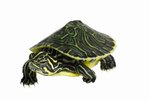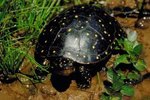Yellow-bellied sliders (Trachemys scripta scripta.), native to the southeastern United States, are close relatives of red-ear sliders (Trachemys scripta elegans). They make excellent display specimens in elaborate, well-planted tanks or ponds. You can include fish in a yellow-bellied slider enclosure ether as a deliberate food source or as tank mates.
Diet of the Yellow-Bellied Slider
Like many aquatic turtles, yellow-bellied sliders exhibit ontogenetic or age-related dietary shifts. Hatchlings and young turtles chiefly eat worms, insects and small fish. As they mature, their diets shift and they become primarily plant-eaters, though they will still consume insects, fish and carrion. In captivity, a diverse diet is ideal, though commercial turtle pellets can form a significant portion of the diet for both young and mature turtles.
Strategy
You can keep yellow-bellied sliders with fish, but predation may occur. Some keepers accept that the turtles will eat the fish; they treat the fish as a food source, replacing the fish as they are eaten. Alternatively, some keepers strive to treat fish as pets rather than as turtle food. Fish are possible sources of parasites that may or may not affect your turtle; consult with your veterinarian before introducing live fish to your turtle enclosure for food or long-term captive living.
Environmental Considerations
Yellow-bellied sliders, like many turtle species, are adaptable to varying water quality; they don’t usually require chemical monitoring if the water is kept clean. While chlorine and chloramine should be removed or neutralized, water for turtles needn’t be cycled -- you can completely replace it at once without causing problems. Fish are different; they require properly calibrated water chemistry. In most circumstances, yellow-bellied sliders will thrive in water appropriate for common freshwater pet-store fish species. Turtles do prefer warm water, and fish comfortable in tropical water temperatures must be selected if they are to thrive long-term.
Keeping the Turtles Safe
While hungry turtles will attempt to eat fish, large and aggressive specimens will attempt to eat turtles. Prevent this by refraining from using highly predatory fish species like bass (Mircorpterus sp.), large African cichlids and large catfish. You can keep aggressive species with turtles if they are smaller than the turtles; in general, the turtles must be larger than the fishes’ heads.
Fish Likely to Be Eaten
Slow, medium-size fish are the most at risk of being eaten. Goldfish (Carassius auratus) and sluggish bottom feeders are at high risk of predation. Sucker fish (Hypostomus plecostomus) may be successfully kept with well-fed mature sliders, but hungry turtles will not hesitate to consume even large suckerfish. Some suckerfish have been observed attaching themselves to turtles, consuming the algae on the turtle’s shell. Neither the algae nor the fish consuming the algae are any danger to the turtles.
Fish Likely to Evade Turtles
Sunfish, particularly warm-water-tolerant species like the long-ear sunfish (Lepomis megalotis), are well-suited to living with yellow-bellied sliders. Sunfish of about 4 inches in length are large enough that they won’t be viewed by well-fed turtles as a food source and won't be large enough to eat the turtles. Warmouth (L. gulosus) and green (L. cyanellus) sunfish will also thrive in the warm water of a turtle tank and are fast swimmers. Guppies (Poecilia reticulata) are small, but they are very quick fish and will typically evade turtles, though turtles may nip the fins of fancy-finned varieties.
References
- Austin’s Turtle Page: Yellow Bellied Slider
- The Cold Blooded News: Turtles and Fish Together?
- Austin’s Turtle Page: What Can I Keep With a Turtle?
- United States Geological Survey: Trachemys scripta scripta
- University of Oregon: The Introduction of Myxozoan Parasites Through the Release of Feeder Goldfish (Carassius auratus)
Photo Credits
-
George Doyle/Stockbyte/Getty Images



